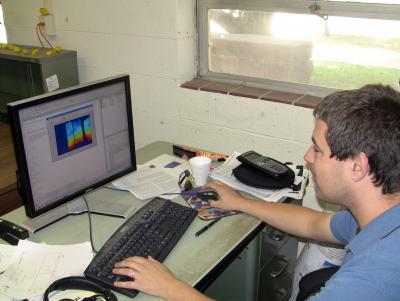NMSU graduate student studies Martian dust storms through NASA fellowship

Robert Edmonds is the second graduate student in the Department of Astronomy to receive the NASA Earth and Space Science Fellowship for 2012. Candace Gray recently received the same fellowship to study how the nightglow changes after solar flares and coronal mass ejections impact Venus.
Recent Mars atmospheric temperature data obtained by the Mars Reconnaissance Orbiter spacecraft show evidence of atmospheric turbulence, which might be related to gravity waves, or buoyancy, within Mars' atmosphere.
These possible gravity wave effects were seen during a Northern Hemisphere autumn prior to the development of a planet-wide dust storm within one observed year. During the subsequent observed year neither the turbulence signature nor a large-scale dust storm occurred.
It is possible the gravity waves might play a role in enabling or permitting Martian dust storm development.
"This fellowship is allowing me to further explore that idea and see if gravity waves do actively have an effect on dust storm development in Mars' atmosphere,' Edmonds said. His thesis is titled, "Investigating the Effects of Gravity (Buoyancy) Waves Upon the Martian Atmosphere, with Emphasis Upon Dust Storm Interactions."
Mountains and terrains have the ability to affect the atmosphere far above the Earth's surface.
Atmospheric gravity waves are important to Earth's atmosphere. The waves convey atmospheric momentum from low altitudes to high altitudes where they accelerate/decelerate the winds and cause vertical mixing and atmospheric turbulence.
The same thing happens on Mars, Edmonds said, even though it has a much thinner atmosphere.
There are satellites in orbit around Mars that are taking temperature measurements of the Martian atmosphere. Edmonds is currently going through that data to see if and how the gravity waves affect the atmosphere.
"Right now, we see gravity waves possibly depositing momentum in the atmosphere and we see lots of these events right up to the run up of a dust storm," Edmonds said. "Why are they breaking right at this moment? Is the effect because there are more gravity waves being excited or is the effect of background environment making the waves break? That is what I am working on."
Jim Murphy, associate professor of astronomy and Edmonds' adviser, says he's pleased that Edmonds received the fellowship. Edmonds began his graduate work at NMSU in 2008. The $30,000 NASA fellowship can be renewed annually for up to three years.
"He joined our NMSU program with a very good undergrad education from the University of New Mexico, and in addition brought with him an interest in atmospheric sciences related to his keen interest in storm chasing," Murphy added. "It was a natural fit for him to develop an interest in studying the atmosphere of another planet in our solar system."
These gravity waves Edmonds is focusing on for his Mars studies are important waves in Earth's atmosphere and have effects at small spatial scales, such as clear air turbulence experienced by aircraft, and larger scales that can affect the jet stream. Work that has been conducted to date suggests these waves could be significant for a variety of Mars atmospheric dynamical characteristics.
"Robert's focus upon their interaction with the occurrence of Martian global scale dust storms is especially intriguing," Murphy said. "Learning that these waves play a direct or indirect role in these storms developing would be a grand new discovery and if real, could provide some "forecast" ability for the development of those dust storm events, which is useful for spacecraft mission planning, especially when we start sending humans to Mars."
Edmonds began his graduate work at NMSU in 2008. The $30,000 NASA fellowship can be renewed annually for up to three years.


